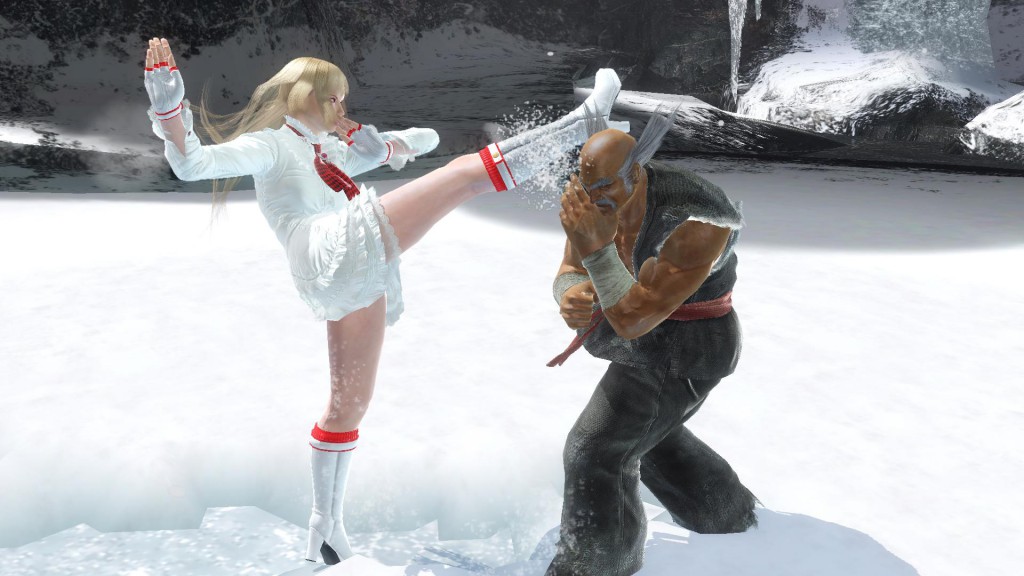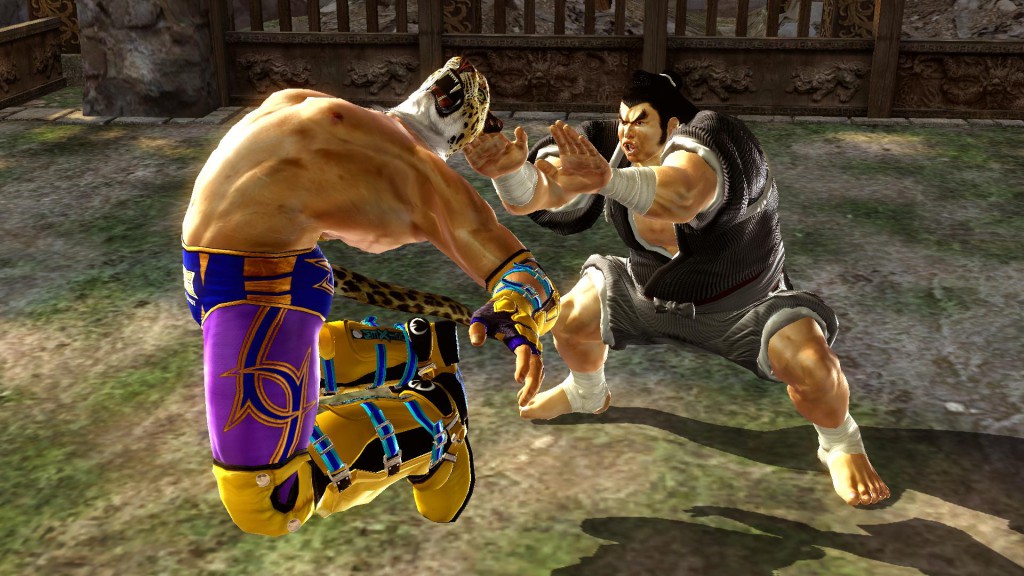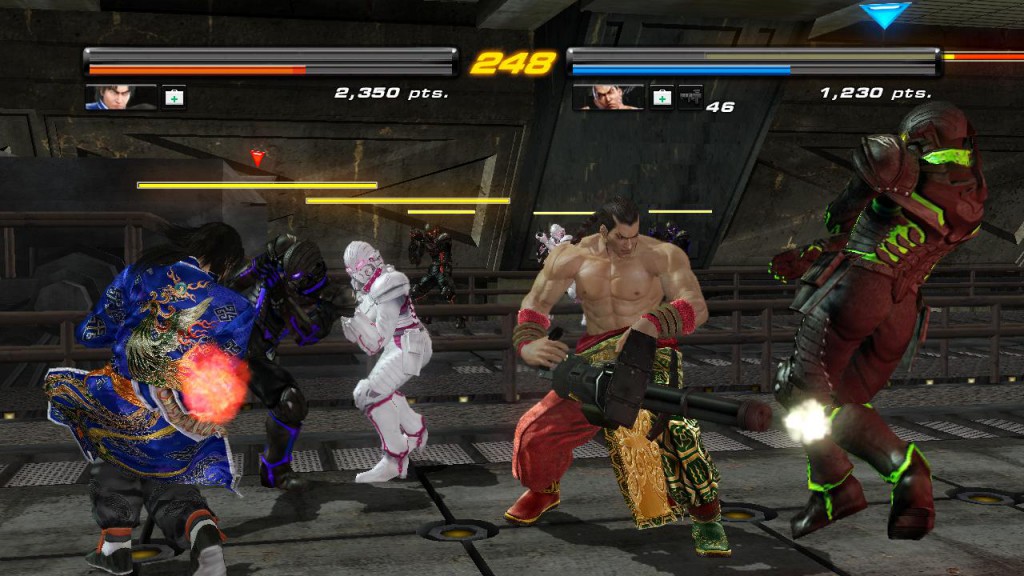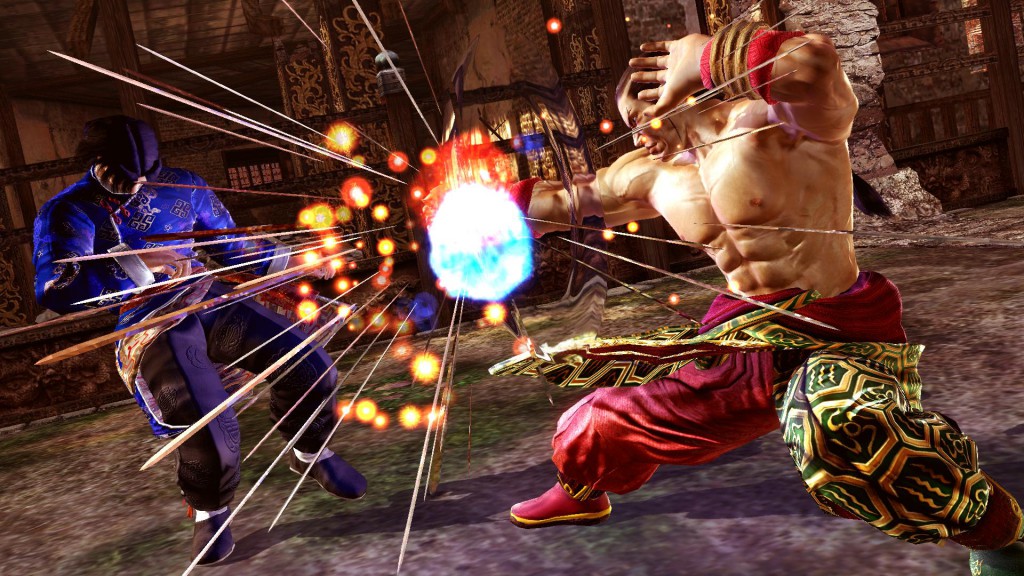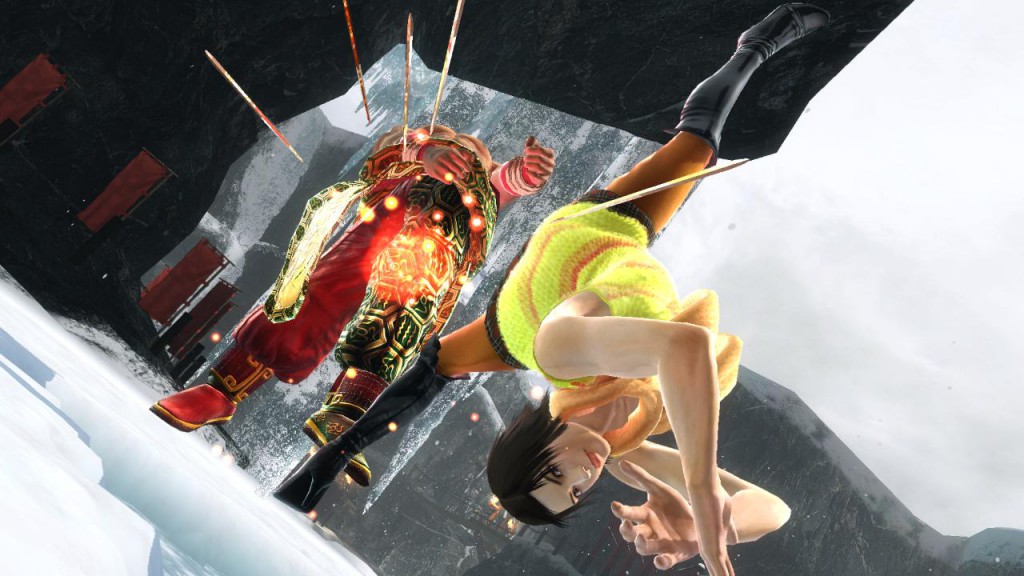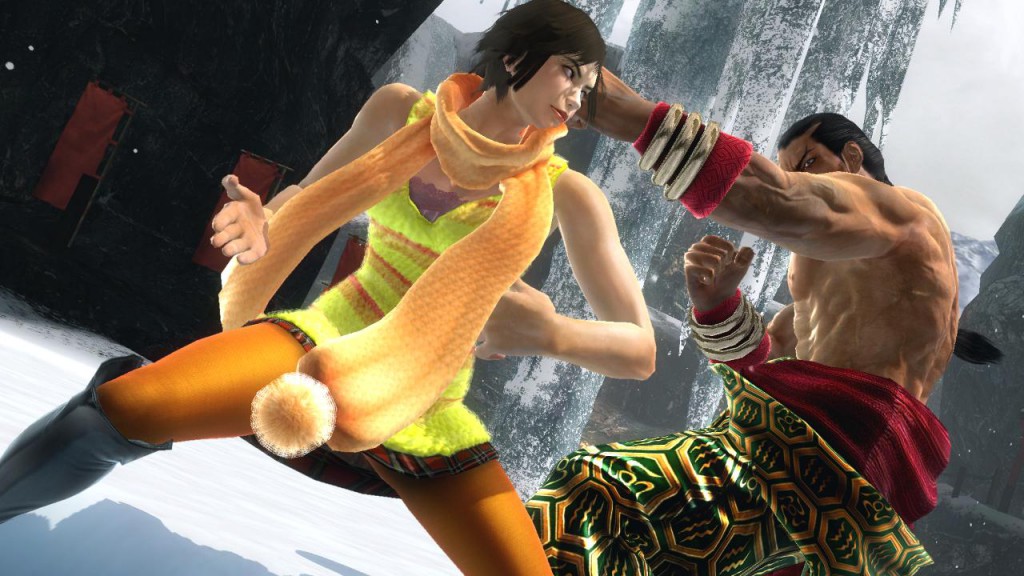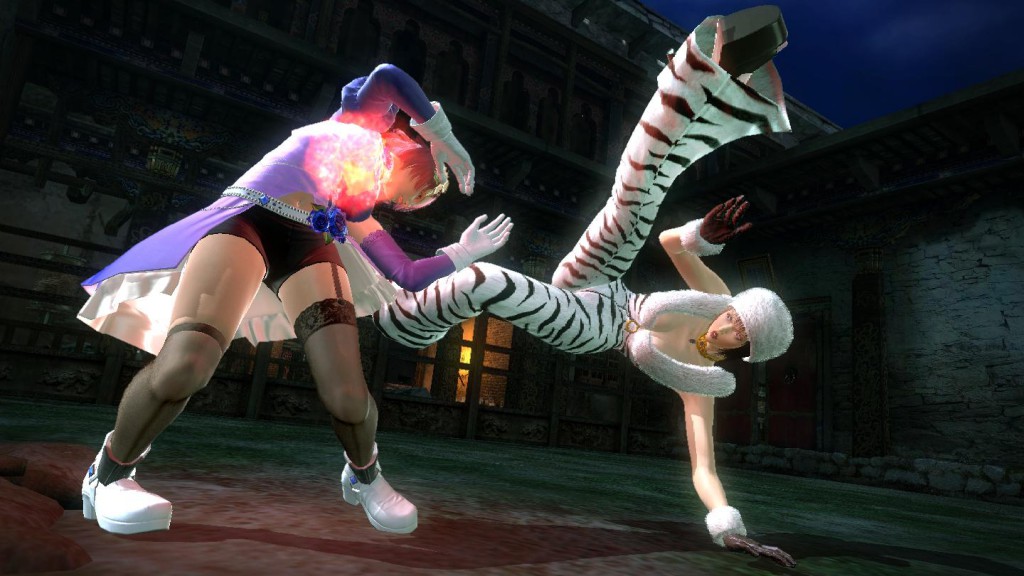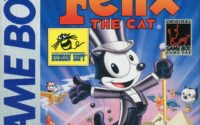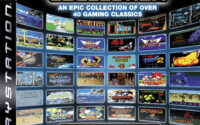Tekken 6 Review
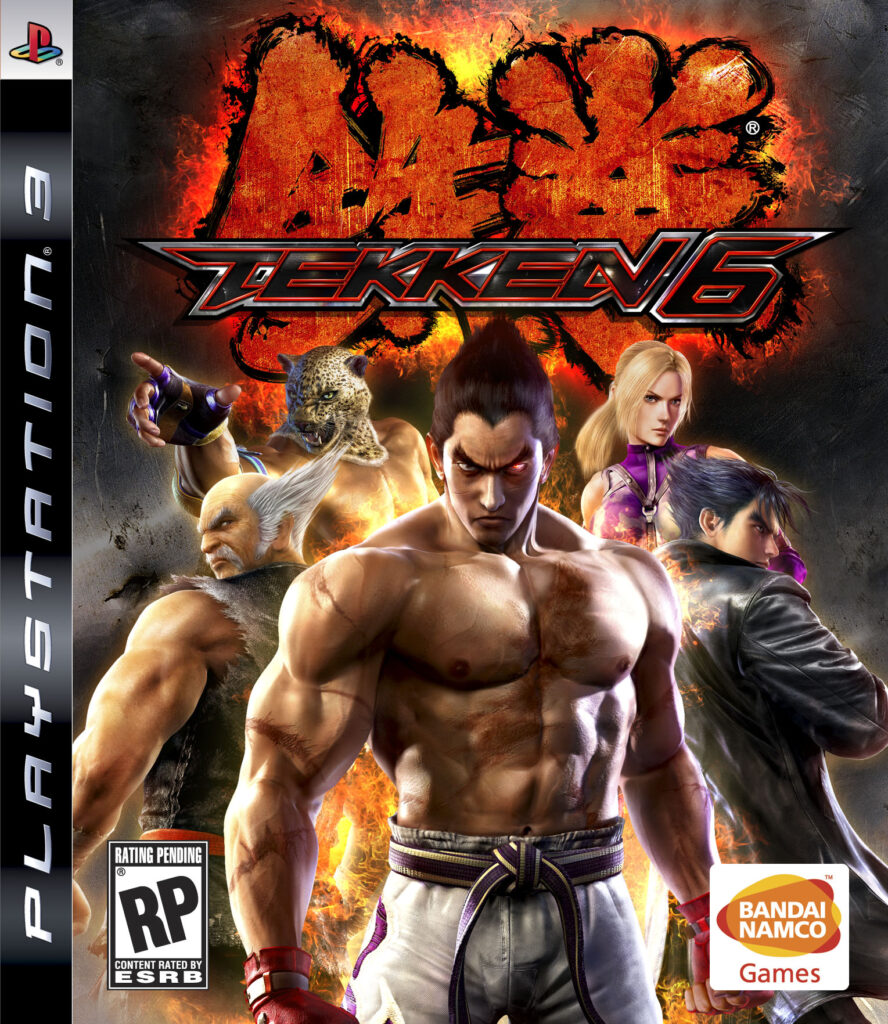
All out brutal violence in one of the finest 3D fighting games around.
Story
Jin Kazama has taken charge of the Mishima Zaibatsu corporation and now holds tyrannical ambitions. Using his resources within the organization to become a global superpower, he severs the Mishima Zaibatsu’s national ties and openly declares war against all nations. This action plunges the world into a chaotic spiral, with war erupting around the globe and even amidst the space colonies orbiting the planet. His biological father, Kazuya Mishima, is aware of this and finds Jin’s interference in his own plans for global domination to be a nuisance. Now in charge of G Corporation, Kazuya is seen as the only force who could oppose Jin and places a bounty on Jin’s head for anyone who can capture him. Jin’s response is to announce The King of Iron Fist Tournament 6 in order to battle Kazuya and crush G Corporation.
The Game
Tekken 6 for the home consoles is based on the arcade game Tekken 6 Bloodline Rebellion, which is an updated version of the original arcade game Tekken 6.
The story line in these games is somewhat vague, but there is a thread following through the entire series. That thread is explained in Tekken 6, and some new light is shed on past events. This game is therefore a perfect opportunity to jump right in on the story – whether you’re a newcomer or have been away from the series for a while. However, these games have never really been about the story in the first place. Tekken games have always stood as one of the best and coolest 3D fighting games around.
Tekken 6 is all about brutal fighting violence. As a 3D fighting game, Tekken 6 does utilize side stepping, walls combos, juggle combos and so on as a central part of the game. The fights are typically regular one-on-one no-rules matches on a set number of rounds.
One of the new features that Tekken 6 introduces is the Rage System. This means that when a character is low on health, he will enter a special “rage status”, meaning that his attacks will cause more damage than normal. In its essence, this is basically an opportunity for the losing fighter to catch up and perhaps turn the round to his advantage, and as such it is a great tool – a very nice addition to the game.
Controls
The control scheme in Tekken 6 stays pretty much the same from previous Tekken games. The game is played with four buttons and one directional stick or pad. Each button represents one limb of your character, so the Square button translates into a punch with your left hand. Triangle button, a punch with your right hand. Cross button, a kick with your left leg and Circle button, a kick with your right leg. On this premise you can make various combos by chaining together different combinations of the buttons – most, if not all combos are character specific, so you have to learn them on a character-to-character basis.
Playing the game on an arcade stick has its obvious advantages – not only is it more true to the original arcade experience, it’s also more convenient. Counters and throws, for example, are executed by pressing two buttons together – doing this on the buttons of an arcade stick is no problems but it can be quirky to pull off on a Dual Shock 3.
Stringing together combos and special attacks is obviously a central part of the game, as with any other serious fighting game out there. Tekken 6 is however generally pretty forgiving in that it doesn’t require frame-by-frame precision timing in all its combos. This means that your timing can be a little off – at least for the basic combos – but still be able to execute the intended combo.
On the other hand, the game has lots of advanced stuff to its controls that you can’t learn by simply looking at move lists. Juggling combos, crouch dash canceling, specific wall combos, escaping throws etc are such moves to name a few.
The Bound System is a new feature to Tekken 6 and it basically means that each character has some moves that have a “bound” property. If one such move is used to finish off a combo, it has the potential to allow for further, longer juggling combos than what’s otherwise possible.
The Scenario Campaign mode is played from a third-person camera view, rather than from the side. In order to be able to navigate through the stage you’re thus forced to play with two different control schemes – the regular one where you jump by hold up, and the Scenario Campaign specific one where you walk forward by holding up. The game switches between these two depending on whether you’re engaged in combat or not, and you can also manually control it by holding L1. Needless to say, this can be the source for some frustration – especially when you have a bunch of thugs beating you up on the same time as you try to navigate through the area and collect treasure chests.
Also, the AI of your partner isn’t smart enough to collect power-ups that it needs. Rather, it seems to collect stuff just as it happens to walk over them. This means that you may have to literally push her into the health power-ups that she needs when she gets hurt.
The weakest part of this whole game mode is how the targeting system works – you must constantly switch targets manually because the auto target feature insists on targetting enemies that you just knocked out.
The Scenario Campaign mode is also very inconsistent in how it saves your check points within the stages – sometimes you can retry the game from the boss fight, and other times you have to replay the whole stage.
Content
There are multiple fighting styles depicted in the game along with some supernatural elements and high-tech robots. There are 40 playable characters in the game, and each character has around 100 special moves i.e. kicks, punches, throws, combos, counters, follow-up attacks and unblockable attacks and so on. Mastering a character can thus be a daunting task – but once you get into the game you’re sure to find your favorite characters and preferred play style.
There are six new characters in Tekken 6 along with 34 returning characters from previous games in the series. The new characters introduced in Tekken 6 are;
- Bob – a former martial arts master who returns to the scene to test his new fighting style.
- Leo – a young spelunker looking to avenge the death of her mother.
- Miguel Caballero Rojo – a hot-tempered man looking to avenge the Mishima Zaibatsu as they’re found responsible for the death of his sister.
- Zafina – an astrologist and clan assassin looking to hinder the end of the world.
- Alisa Bosconovitch – a mysterious robot girl found in a secret Russian laboratory.
- Lars Alexandersson – a ranking officer of the special military unit Tekken Force, who aims to put an end to the madness of Mishima Zaibatsu corporation.
Furthermore the game introduces two new boss characters; Azazel, an ancient demon and Nancy, a huge war machine. As boss characters they’re normally not playable, and thus they’re excluded from the cast.
With all these characters in the cast the game has lots of variation and supports tons of different play styles. As with all other fighting games the characters have been ranked on unofficial tier lists (which are inclined to change) that shows which characters are the most- and least powerful. Despite this the character balance is fair and basically as good as they come. Yes, there are some characters like Steve Fox and Bob who appear to be at an advantage over others, but this shouldn’t break the game for you.
The different game modes you can play in Tekken 6 are; Scenario Campaign, Arcade, VS Battle, Practice, Survival, Time Attack, Team Battle and Ghost Battle. The online features include Player Matches and Ranked Matches as well as detailed Leaderboards, replay downloads and ghost data downloads.
Player Matches do not affect your rank, and in this mode you can either create a session, invite friends to play with you or play Quick Matches against random people. You can also create custom search filters and search for sessions that other people have started. Sessions are basically meeting rooms for a pool of players where you can communicate and launch games between each other.
The Ranked Matches mode does allow you to filter your search on either connection quality and region or both, which is a nice feature and should help you find games with decent playability. In reality, most ranked matches tend to lag because of technical limitations and geographical distance of the players.
The Scenario Campaign mode is a story based game within the Tekken universe. The story is about Lars Alexandersson and the mysterious android girl Alisa Bosconovich who fight the Mishima Zaibatsu corporation.
There are almost 30 stages (optional- and hidden ones included) on an overview world map, and between each stage you’ll unveil the next segment of the story. Even though the story is originally about Lars, you get to select what character to play, and you will unlock new playable characters as you progress through the story.
The stages are short and peppered with thugs for you to beat up. Alisa is controlled by the AI and fights by your side. Every now and then you’ll find treasure chests which hold items that you can equip between stages and through that gain special bonuses. Through these items you can customize your character on various variables such as damage output, defense and elemental attacks and resistance. These items will stay on your character over to other game modes too, but needless to say, they won’t keep their bonus properties – instead, it effectively becomes customization options for your virtual costume wardrobe.
You can also find temporary weapons such as miniguns, flame throwers and baseball bats. These are limited by how many times you can use them, and they also slow you down considerably which really make them poor options most of the time.
The Scenario Campaign mode is a fun addition to the game. Nothing more, nothing less. If you play it consistently you’ve beaten it in a day or two. Note that unlocking characters is only required in the Scenario Campaign mode. As for the other game modes, all characters are made available right out of the box.
Most other game modes are what you expect them to be; Arcade mode is a series of fights where Azazel stands as the final boss. Time Attack is basically the same as Arcade mode – your goal is to beat the game in the least possible time. Team Battle lets you play in teams against the CPU or another player. In Survival mode you only get one health bar and your goal is to beat as many opponents as possible before being knocked out yourself. Each match you win rewards you with some health back.
The game keeps your records for each game mode in a score table, but this score table isn’t well suited to be shared with other players locally. For one thing, it doesn’t allow you to enter player names. So, if you want to compare scores with another player you’d either have to do it manually (across accounts on the same console) or via the PSN online service. It’s also odd that it stores data about all your wins and losses, whether you want it or not.
When playing so-called Quick Matches online you only get one fight – no rematches. This means that you’ll spend more time synchronizing with servers, searching for players and loading the game than actually playing.
After installing the free patch that was released 2009-11-27, the game has become upfront about the connection status to other players and their sessions. You can cancel a game that you deem have a too weak connection and thus avoid the worst matches when it comes to connection quality. But it can be hard to find games where the connection is acceptable. Even when the status seems okay there will be some lag, so be prepared for it when you play online.
Ghost Battle mode is a special game mode where you fight against virtual opponents, controlled by the CPU. But this CPU is different from the regular AI in that it is based on so called ghost data. It is said to assume the fighting style of another human player, and the game comes loaded with ghost data opponents out of the box. It’s hard to tell however how well it actually emulates another player, and you can download ghost data from basically any player that you see online.
Practice mode allows you to practice special moves and combos on a target dummy. You get to see each character’s move list and how all the moves are executed. You are also treated with timing information, so that you can both see and hear the correct timing of each button press in a combo, which makes it much easier to learn compared to by merely looking at instructions.
Even though the game shows you some combos in the Practice mode, there are lots of combos and ways to link attacks that you must discover yourself.
The target dummy can either be controlled by another human player or the CPU, or you can have it follow some basic instructions, and even single out what special moves it should use against you. It does not allow you to record your own moves and combos and then practice against the recording, which is a painful omission in a competitive game like this.
Each character on your personal profile is ranked by grade. Based on how well you play during Arcade mode and Ghost Battles, you’ll get to fight special matches where you have a chance to be promoted and raise the grade of the character that you’re currently playing. When you get promoted the game will naturally become harder, as if the game adjusts to your skill level. If you fail to win the promotional match you’ll get to try again at a later time. This means that the game assumes that your skill level becomes better the more time you spend with the game, but that’s certainly not true all of the time. Obviously you can’t reach the top grades without playing online against other players, so there is a limit to how far you can go by only playing offline.
Regardless of what game mode you play, you’ll earn so-called Fight Money. This is the currency that you use to buy new pieces of clothing. The game has tons of different and character specific clothing, color options and so on – hats, glasses, bracers, gloves, chest pieces, leg pieces, shoes etc. Most of these are only for cosmetic reasons, but there are also some special items that can be used to perform special attacks. There’s a lot to see in this game when it comes to character costumes, and it’s all customizable which is super nice.
On top of all this, the game has a bunch of bonus features such as movies, replay features and PlayStation Home related items. There’s also 50 PlayStation Trophies to be earned for those who wants some extra challenges.
As a casual fighting game Tekken 6 is a solid choice. The game is fun right from the start, even if you don’t know any combos or moves. As long as you play with equally skilled players the game does deliver a great experience.
If you play alone, your time is best spent practicing or trying to beat your own personal records. If you choose to delve deeper into the game and start experimenting with juggle combos and advance strategies, you’ll have fun with the game for a very long time – there is a lot to discover, and tons of characters to play around with. The game is very addicting if you’re into fighting games at all.
Graphics
The graphics in Tekken 6 are awesome. There are 16 different arenas to fight on, apart from the Scenario Campaign mode, and it all has a stunning level of detail. In fact, the whole game is very detailed – you’re able to see the veins and every single muscle on the characters.
The animation is also brilliant. Most punches, kicks and special moves look very realistic. There are, of course, also a great deal of juggling combos and so on that defy all laws of physics, so the illusion of realism is broken every now and then. But it’s still an impressive sight overall. Especially the winning poses that occur after any given fight stand out as super cool, memorable and original.
There are some graphical effects at work here that uplifts the visual presentation above what you’d normally see in a 3D fighting game – especially the lighting has a major role in making dramatic visuals here, and it works really well.
Sound
The music in the game explores many different genres and moods – there’s everything from cheery music, chill out ambient, hysteric techno and gritty hard-core metal. Each of the 16 stages has its own music, and it all fits in nicely. There are many great songs in the mix, so the soundtrack is definitely up to par with the high standard of the game.
The voice acting is also very well done, but it’s kind of weird how they mix Japanese and English voices – apparently everyone understands any spoken language in the Tekken universe.
There are tons of painful cries, screams, yells, taunts, comments and so on for each character, so the persons in the game feel very much alive in that sense.
Summary
Tekken 6 is pretty much what you make of it. It can be a casual arcade experience, or you could spend hundreds of hours perfecting combos and studying strategy guides and pro hints. The online mode does help you connect to a community of players, but if you want to play without any interference you’d best invite a buddy over and play locally.
Either way you play it you’re guaranteed to have lots of fun. If you’re into fighting games, then Tekken 6 is too good to miss!

